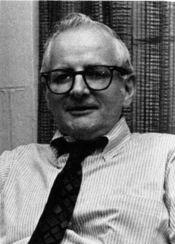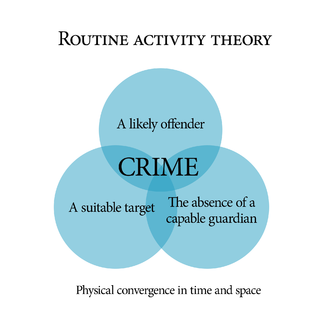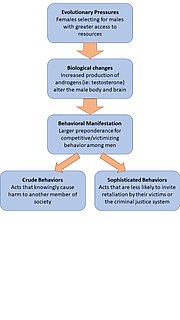
The Bell Curve: Intelligence and Class Structure in American Life is a 1994 book by psychologist Richard J. Herrnstein and political scientist Charles Murray, in which the authors argue that human intelligence is substantially influenced by both inherited and environmental factors and that it is a better predictor of many personal outcomes, including financial income, job performance, birth out of wedlock, and involvement in crime than are an individual's parental socioeconomic status. They also argue that those with high intelligence, the "cognitive elite", are becoming separated from those of average and below-average intelligence, and that this separation is a source of social division within the United States.
James Quinn Wilson was an American political scientist and an authority on public administration. Most of his career was spent as a professor at UCLA and Harvard University. He was the chairman of the Council of Academic Advisors of the American Enterprise Institute, member of the President's Foreign Intelligence Advisory Board (1985–1990), and the President's Council on Bioethics. He was Director of Joint Center for Urban Studies at Harvard-MIT.

Richard Julius Herrnstein was an American psychologist at Harvard University. He was an active researcher in animal learning in the Skinnerian tradition. Herrnstein was the Edgar Pierce Professor of Psychology until his death, and previously chaired the Harvard Department of Psychology for five years. With political scientist Charles Murray, he co-wrote The Bell Curve, a controversial 1994 book on human intelligence. He was one of the founders of the Society for Quantitative Analysis of Behavior.
Crime science is the study of crime in order to find ways to prevent it. Three features distinguish crime science from criminology: it is single-minded about cutting crime, rather than studying it for its own sake; accordingly it focuses on crime rather than criminals; and it is multidisciplinary, notably recruiting scientific methodology rather than relying on social theory.
Hereditarianism is the doctrine or school of thought that heredity plays a significant role in determining human nature and character traits, such as intelligence and personality. Hereditarians believe in the power of genetics to explain human character traits and solve human social and political problems. Hereditarians adopt the view that an understanding of human evolution can extend the understanding of human nature.

Leon J. Kamin was an American psychologist known for his contributions to learning theory and his critique of estimates of the heritability of IQ. He studied under Richard Solomon at Harvard and contributed several important ideas about conditioning, including the "blocking effect".

Right realism, in criminology, also known as New Right Realism, Neo-Classicism, Neo-Positivism, or Neo-Conservatism, is the ideological polar opposite of left realism. It considers the phenomenon of crime from the perspective of political conservatism and asserts that it takes a more realistic view of the causes of crime and deviance, and identifies the best mechanisms for its control. Unlike the other schools of criminology, there is less emphasis on developing theories of causality in relation to crime and deviance. The school employs a rationalist, direct and scientific approach to policy-making for the prevention and control of crime. Some politicians who ascribe to the perspective may address aspects of crime policy in ideological terms by referring to freedom, justice, and responsibility. For example, they may be asserting that individual freedom should only be limited by a duty not to use force against others. This, however, does not reflect the genuine quality in the theoretical and academic work and the real contribution made to the nature of criminal behaviour by criminologists of the school.

In criminology, the Neo-Classical School continues the traditions of the Classical School within the framework of Right Realism. Hence, the utilitarianism of Jeremy Bentham and Cesare Beccaria remains a relevant social philosophy in policy term for using punishment as a deterrent through law enforcement, the courts, and imprisonment.

Integrative criminology reacts against single theory or methodology approaches, and adopts an interdisciplinary paradigm for the study of criminology and penology. Integration is not new. It informed the groundbreaking work of Merton (1938), Sutherland (1947), and Cohen (1955), but it has become a more positive school over the last twenty years.

The feminist school of criminology is a school of criminology developed in the late 1960s and into the 1970s as a reaction to the general disregard and discrimination of women in the traditional study of crime. It is the view of the feminist school of criminology that a majority of criminological theories were developed through studies on male subjects and focused on male criminality, and that criminologists often would "add women and stir" rather than develop separate theories on female criminality.

Routine activity theory is a sub-field of crime opportunity theory that focuses on situations of crimes. It was first proposed by Marcus Felson and Lawrence E. Cohen in their explanation of crime rate changes in the United States between 1947 and 1974. The theory has been extensively applied and has become one of the most cited theories in criminology. Unlike criminological theories of criminality, routine activity theory studies crime as an event, closely relates crime to its environment and emphasizes its ecological process, thereby diverting academic attention away from mere offenders.
Nicole Hahn Rafter was a feminist criminology professor at Northeastern University. She received her Bachelor of Arts degree from Swarthmore College in Pennsylvania, achieved her Master of Arts in Teaching from Harvard University, and obtained a Ph.D. in Criminal Justice from State University of New York in Albany. She began her career as a high school and college English professor and switched to criminal justice in her mid-thirties.

Biosocial criminology is an interdisciplinary field that aims to explain crime and antisocial behavior by exploring biocultural factors. While contemporary criminology has been dominated by sociological theories, biosocial criminology also recognizes the potential contributions of fields such as behavioral genetics, neuropsychology, and evolutionary psychology.
Jody Miller is a feminist criminology professor at the School of Criminal Justice at the Rutgers University (Newark). Her education includes: B.S. in journalism from Ohio University, 1989 ; M.A. in sociology from Ohio University, 1990; M.A. in women's studies at Ohio State University, 1991; and her Ph.D. in sociology from the University of Southern California in 1996. She specializes in feminist theory and qualitative research methods. Her research focuses on gender, crime and victimization, in the context of urban communities, the commercial sex industry, sex tourism, and youth gangs. Miller has also been elected as the vice president of the American Society of Criminology for 2015, the executive counselor of the American Society of Criminology for 2009–2011, as well as received the University of Missouri-St. Louis Chancellor's Award for Excellence in Service in 2007.

Criminology is the study of crime and deviant behaviour. Criminology is an interdisciplinary field in both the behavioural and social sciences, which draws primarily upon the research of sociologists, political scientists, economists, psychologists, philosophers, psychiatrists, social workers, biologists, social anthropologists, as well as scholars of law.
Anthony Allan Braga is an American criminologist and the Jerry Lee Professor of Criminology at the University of Pennsylvania. Braga is also the Director of the Crime and Justice Policy Lab at the University of Pennsylvania. He previously held faculty and senior research positions at Harvard University, Northeastern University, Rutgers University, and the University of California at Berkeley. Braga is a member of the federal monitor team overseeing the reforms to New York City Police Department (NYPD) policies, training, supervision, auditing, and handling of complaints and discipline regarding stops and frisks and trespass enforcement.
David Philip Farrington is a British criminologist, forensic psychologist, and emeritus professor of psychological criminology at the University of Cambridge, where he is also a Leverhulme Trust Emeritus Fellow. In 2014, Paul Hawkins and Bitna Kim wrote that Farrington "is considered one of the leading psychologists and main contributors to the field of criminology in recent years."

In criminology, racial invariance refers to a hypothesis that the effects of structural disadvantage on rates of violent crime are the same for all racial groups. This hypothesis is a major component of structural perspectives on the causes of crime, such as social disorganization theory and anomie. It can be traced back to William Julius Wilson's 1987 book The Truly Disadvantaged, which argued that racial differences in crime rates are due to differences in the communities in which American whites and blacks live. Since then, it has become a major component of the general theory of crime.
Donald Arthur Andrews was a Canadian correctional psychologist and criminologist who taught at Carleton University, where he was a founding member of the Institute of Criminology and Criminal Justice. He is recognized for having criticized Robert Martinson's influential paper concluding that "nothing works" in correctional treatment. He also helped to advance the technique of risk assessment to better predict the chance of recidivism among offenders. He is credited with coining the terms "criminogenic needs" and "risk-need-responsivity", both of which have since been used and studied extensively in the criminological literature.

The evolutionary neuroandrogenic (ENA) theory is a conceptual framework which seeks to explain trends in violent and criminal behavior from an evolutionary and biological perspective. It was first proposed by the sociologist Lee Ellis in 2005 in his paper "A Theory Explaining Biological Correlates of Criminality" published in the European Journal of Criminology. Since then, it has expanded into an interdisciplinary field that intersects biology, psychology, and sociology. The theory rests on two propositions. The first is that in human mating behavior, females prefer males that appear to be more competent providers of resources, and so males exhibit increased competitive behavior than females to obtain access to those resources. The second is that biological mechanisms lead to differential development in the male brain which then mediates the increased competitive behaviors that cause criminality. Though it was originally intended to explain high rates of criminality in young men, it has since been used as a framework to explain gang behavior, terrorism, and the rise of the criminal justice system.







